上一章React Native实战教程请查看:React Native状态state介绍和用法
在上一章中,我们展示了如何使用可变state状态,在本章中,我们将向你展示如何组合状态state和prop。
表示组件应该通过传递prop来获取所有数据,只有容器组件应该有状态state。
容器组件
现在我们将了解什么是容器组件,以及它是如何工作的。
理论
现在我们将更新容器组件,该组件将处理状态state并将prop传递给表示组件。
容器组件仅用于处理状态state,所有与视图(样式等)相关的功能都将在表示组件中处理。
例子
如果我们想使用上一章的例子,我们需要从render函数中删除Text元素,因为这个元素用于向用户显示文本,这应该在表示组件内部。
让我们回顾一下下面给出的例子中的代码,我们将导入PresentationalComponent并将其传递给render函数。
导入PresentationalComponent并将其传递给render函数后,需要传递prop。我们将通过添加myText = {this.state.myText}和deleteText = {this.deleteText}传递prop到<PresentationalComponent>,现在,我们将能够在表示组件中访问它。
App.js
import React from 'react';
import {StyleSheet, Text, View} from 'react-native';
import PresentationalComponent from './PresentationalComponent';
export default class App extends React.Component {
state = {
myState: 'React Native prop介绍和用法 - React Native实战教程',
};
updateState = () => {
this.setState({myState: 'The state is updated'});
};
render() {
return (
<View>
<PresentationalComponent
myState={this.state.myState}
updateState={this.updateState}
/>
</View>
);
}
}

表示组件
现在我们将理解什么是表示组件,以及它是如何工作的。
理论
表示组件应该只用于向用户表示视图。这些组件没有状态state,他们接收所有的数据和功能作为prop。
最佳实践是使用尽可能多的表示组件。
例子
正如我们在前一章中提到的,我们对表示组件使用EC6函数语法。
我们的组件将接收prop,返回视图元素,使用{prop.myText}显示文本,并在用户单击文本时调用{props.deleteText}函数。
PresentationalComponent.js
import React, {Component} from 'react';
import {Text, View} from 'react-native';
const PresentationalComponent = props => {
return (
<View>
<Text onPress={props.updateState}>{props.myState}</Text>
</View>
);
};
export default PresentationalComponent;
现在,我们有了与State章节相同的功能,惟一的区别是,我们将代码重构为容器和表示组件。
你可以运行该应用程序,并看到如下面的屏幕截图中的文本。

 srcmini
srcmini
评论前必须登录!
注册